Exploring Drusy: Characteristics and Cultural Significance

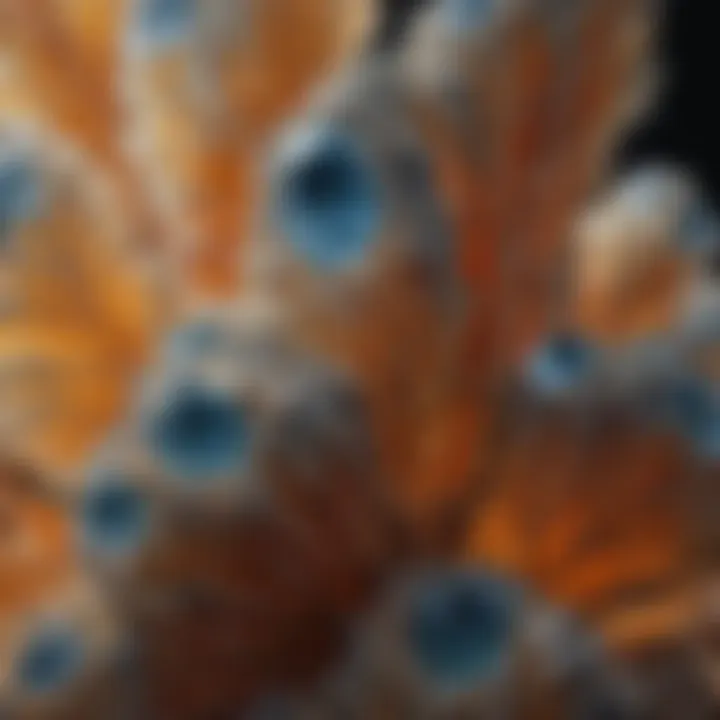
Intro
Drusy formations in gemstones have caught the fascination of many collectors and enthusiasts. Drusy, often characterized by a glittering layer of tiny crystals on its surface, offers both beauty and unique qualities. These natural wonders can be found in various types of gemstones, each with its own attributes and significance. This exploration will provide insights into the characteristics of drusy, the classification of gemstones, an overview of physical and chemical properties, and importantly the cultural implication these stones hold in different societies.
Gemstone Overview
Definition and Characteristics
Drusy is defined as a layer of small, sparkly crystals that form on the surface of existing stones. This crystallization occurs as minerals precipitate from the solution, typically creating a secondary layer of crystals. The visual texture tends to be distinctive, often resembling a fine dusting of sugar over a surface. Drusy can be found on a variety of base stones, including agate, quartz, and calcite.
Key characteristics of drusy gemstones include:
- Sparkling appearance: The small crystals create a shimmering effect that is visually captivating.
- Variety of colors: Depending on the base mineral, drusy can exhibit a broad spectrum of colors.
- Size and shape: It can range from small cabochons to larger geodes.
Classification of Gemstones
Gemstones are classified based on several criteria, including mineral composition, crystal structure, and origin. Drusy formations, specifically, can be classified within crystallized minerals based on their formation processes. They fall under the category of secondary minerals, as they originate from other pre-existing stones. This classification leads to an understanding of their unique formation process, distinguishing them from standard crystals.
Drusy is not merely a stone; it is a testament to the geological processes that create beauty.
Properties of Gemstones
Physical Properties
The physical properties of gemstones, including drusy, encompass aspects such as luster, hardness, and specific gravity.
- Luster: Drusy stones tend to have a vitreous to pearly luster, influenced by the multitude of tiny crystals.
- Hardness: The hardness of drusy depends on the underlying mineral. For example, drusy quartz has a hardness of 7 on the Mohs scale, making it fairly durable.
- Transparency: While some drusy formations are translucent, others may be entirely opaque due to the dense layer of crystals.
Chemical Properties
Chemical properties define the mineral composition of drusy gemstones. Typically made up of silica, drusy quartz can contain traces of other elements, leading to variations in color and quality. For instance, iron inclusions can yield reddish hues, while manganese might produce purple shades. Understanding these chemical properties can also enhance the appreciation of their beauty and uniqueness.
In summary, drusy formations offer a glimpse into the interaction of minerals, with characteristics that reflect the natural world’s complexity. The exploration into their properties, coupled with their cultural significance, enhances their allure, making them a fascinating topic for gemstone enthusiasts.
Prologue to Drusy
Understanding drusy is essential for anyone interested in gemstones, geology, or jewelry design. Drusy refers to a formation where tiny crystal facets cover a surface, creating a unique and visually striking appearance. These surfaces can vary substantially, depending on the type of minerals they emanate from, making each piece distinct. Exploring drusy offers insights into geological processes and the aesthetic qualities that entice collectors and designers alike.
Drusy stones often display remarkable beauty and complexity, which can enhance the quality and value of jewelry. The popularity of these stones has grown in recent years, making them a sought-after element in modern design and collection. They carry significance for different cultures, which further elevates their status and appreciation.
In this section, the exploration of drusy begins with defining the term and its implications in the broader context of gemstones.
Definition and Explanation
Drusy is defined as a layer of minute crystals that can be found on the surface of various minerals. This crystalline coating often forms in sedimentary environments or as a result of geological processes, making drusy an important topic in both gemology and geology. The appearance can range from a sparkling, textured look to a smoother, more polished surface, depending on the size and arrangement of the crystals.
These formations typically occur on a parent mineral, which means that the properties of the underlying stone play a significant role in the overall appearance and appeal of drusy. Common parent minerals include quartz, agate, and calcite, each contributing different colors and clarity to the drusy.
Drusy stones have become popular in the art of jewelry making. Their eclectic surface textures are often desired for both decorative and symbolic purposes. Furthermore, they are recognized for their attractive aesthetic, which combine well with various metals and other gemstones.
"Drusy formations are not only visually appealing but also demonstrate the intricate processes of nature that lead to their creation."
This definition sets the stage for a more comprehensive exploration of drusy, including its formation, types, and the cultural significance that resonates through time and across various societies. Understanding drusy makes a foundation for appreciating the complex beauty of this gemstone.
Formation of Drusy
Understanding the formation of drusy holds significance in appreciating its beauty and value. Drusy arises from specific geological conditions, resulting in unique features across various types. The knowledge of its formation enhances one's ability to identify drusy in nature and in jewelry, making it crucial for enthusiasts and collectors.
Geological Processes
Drusy is most commonly formed through a process known as supergene modification. This happens when certain minerals interact with water, leading to gradual crystallization. During this process, mineral-rich solutions permeate through rock cavities. As they evaporate, they leave behind tiny, crystalline structures. This is where drusy emerges.
Another important geological process is volcanic activity. Drusy can form inside volcanic rocks as gas bubbles create voids. Over time, these voids fill with mineral-rich vapors. The cooling and crystallization of these vapors lead to stunning drusy formations.
Temperature and pressure also play a vital role in determining the quality and characteristics of drusy. For instance, deeper formations subjected to higher pressure often yield more defined crystals. This highlights how variations in geological conditions can lead to diverse drusy types.
Role of Parent Mineral
The parent mineral significantly influences the drusy's appearance and properties. Different base minerals yield distinct drusy minerals. For example, quartz is one of the most common parent minerals that gives rise to quartz drusy. Here, the specific crystallization process leads to the iconic shimmering surface that collectors admire.
When calcite is the parent, the resulting calcite drusy exhibits different characteristics, such as variations in color and luster. Each type of drusy therefore tells a story, connecting it back to its parent mineral. Understanding this relationship is essential not only for identification purposes but also for enhancing artistic expressions in jewelry design.
Distinct Types of Drusy
The exploration of drusy extends into a variety of types that each exhibit unique characteristics and visual appeal. Understanding these distinct types of drusy is essential not only for gem enthusiasts but also for collectors and jewelry designers. Each type can be defined by its mineral composition and crystalline structure, which contribute to its market value and aesthetic qualities. Additionally, the awareness of these distinctions helps consumers make informed decisions regarding purchases and use of drusy specimens in various applications.
Quartz Drusy


Quartz drusy is one of the most recognized types of drusy, characterized by its glittering surface created by tiny quartz crystals. This type can vary in color, ranging from clear to smoky or even rose hues. It is commonly found in geodes and can often be seen enhancing the beauty of jewelry pieces.
Quartz drusy is valued for its durability and versatility. It can be easily cut, polished, and set into various forms of jewelry such as rings, necklaces, and earrings. The sparkle that quartz drusy provides makes it a favored choice among designers looking to add glamour to their work. Furthermore, it is believed to amplify the properties of other gemstones when combined, enhancing its appeal in metaphysical practices.
Agate Drusy
Agate drusy features a banded appearance, with colorful layers that bring depth and complexity to the stone. Each agate drusy piece can display a spectrum of colors, often with unique patterns, making it particularly desirable for artistic jewelry designs. The presence of tiny quartz crystals on its surface further elevates its visual interest.
The formation of agate drusy occurs when mineral deposits fill cavities in volcanic rocks. As a result, this type often carries intrinsic geological stories, appealing to geology enthusiasts. In jewelry, agate drusy can serve as a striking focal point, capable of enhancing the overall design through its beautiful coloration and patterns.
Calcite Drusy
Calcite drusy presents itself with a softer crystalline layer compared to quartz. The color palette of calcite drusy typically includes pastel shades, such as light pink, green, and blue. These subtle hues make it suitable for more delicate and understated jewelry designs.
Calcite is known for its optical properties, such as being able to refract light. This attribute contributes to the unique sparkle seen in calcite drusy. It is often used in pendants and earrings, appealing to those who prefer a gentle and elegant aesthetic. Some believe it possesses specific healing properties related to emotional clarity and communication, further enriching its significance.
Other Notable Types
Beyond quartz, agate, and calcite, the world of drusy includes other notable types such as hematite drusy and dolomite drusy. Hematite drusy features a metallic luster, which creates a bold visual effect. It is especially appreciated in modern jewelry for its statement-making presence. Dolomite drusy, on the other hand, provides a softer alternative with its creamy hues and gentle sparkle.
Each of these types contributes distinct attributes and can cater to different tastes and preferences. The exploration of these various forms deepens the appreciation of drusy as a gemstone, indicating not just its beauty but also its variety in application across different domains. By diving into these types, one cultivates a broader understanding of drusy's multifaceted nature and its place in both the geological and jewelry realms.
Visual Characteristics of Drusy
Understanding the visual characteristics of drusy is essential to appreciate its unique beauty and significance in the gem and jewelry industry. The shimmering, crystal-covered surface is what typically distinguishes drusy from other stones. By examining its crystalline structure and color variations, one can gain deeper insights into how drusy forms and its allure to collectors and enthusiasts.
Crystalline Structure
The crystalline structure of drusy is one of its most captivating attributes. It consists of a multitude of tiny, interlocking crystals that create a glittering surface. This unique formation results from mineral deposits that accumulate on a host rock or mineral, typically in cavities or voids.
These crystals can vary significantly, depending on the type of mineral that creates them. For instance, quartz drusy presents an entirely different texture compared to calcite drusy. The texture of the crystals can exhibit sharp angles and facets, contributing to the stone's light-reflecting properties. The size and arrangement of the crystals also affect how light interacts with the surface, creating varying degrees of sparkle and brilliance. This quality makes drusy a popular choice for jewelry designers aiming to add distinctive visual elements to their creations.
Color Variations
Color variations within drusy stones are extensive, adding to their charm and appeal. The hues can range from soft pastels to deep, vibrant colors. The specific color often depends on the underlying mineral composition. For example, quartz drusy may display clear, white, or even pink tones, while agate drusy might exhibit rich bands of color.
Some factors influence the color of drusy:
- Trace Elements: Small amounts of impurities contribute to the stone's color. Elements like iron can give a reddish hue, while manganese may create shades of pink or purple.
- Underlying Rock: The color of the parent mineral affects how light interacts with the drusy coating, altering its perceived color.
- Treatment: Some drusy stones undergo treatments to enhance their color, making them more vibrant and visually appealing. These treatments can involve dyes or heat processes.
Drusy stones provide an impressive display of color and form, reminding us of nature's artistry.
In summary, the visual characteristics of drusy—particularly its crystalline structure and color variations—not only contribute to its aesthetic appeal but also to its functionality in jewelry design. These properties provide both collectors and casual admirers an enhanced understanding of drusy's uniqueness and the factors that influence its beauty.
The Use of Drusy in Jewelry
Drusy stones have become increasingly popular in the jewelry sector for their unique aesthetic appeal. This interest is driven by a combination of their visual characteristics and the diverse ways they can be utilized in jewelry design. As drusy offers a range of sparkling appearances due to its tiny crystal formations, it attracts both designers and gem enthusiasts alike. The versatility of drusy, along with its relative affordability compared to other gemstones, makes it an attractive option for various types of jewelry pieces.
These factors contribute to drusy's role in the current gemstone market. Jewelers view drusy as an ideal material to create statement pieces and more delicate designs alike. The trends in fashion also play a crucial role in shaping how drusy is perceived in jewelry. As the demand for unique and eye-catching pieces continues to grow, drusy stones effectively fill that niche while providing a luxurious look without the exorbitant price tags often associated with traditional gemstones.
Popular Jewelry Styles
Drusy gemstones can be found across myriad jewelry styles, appealing to various aesthetic preferences. Some popular styles include:
- Earrings: Drusy earrings range from stud types to elaborate dangles, where the shimmering surface catches the light beautifully, enhancing the wearer's features.
- Necklaces: Statement necklaces featuring large drusy pendants are eye-catching and serve as conversation starters. Alternatively, drusy beads are often used in delicate chain designs for a more subtle look.
- Bracelets: Sparkling drusy can be integrated into charm bracelets or used as focal points in cuff designs, adding a touch of elegance.
- Rings: Drusy rings, whether set in gold or silver, often become centerpieces, with their reflective surfaces drawing attention.
These styles reflect the growing appeal of drusy in mainstream jewelry fashion, allowing wearers to express individuality through an extraordinary medium.
Techniques for Setting Drusy
The craftsmanship involved in setting drusy is vital for showcasing its beauty. Different techniques are employed depending on the specific jewelry style and desired effect. Some common methods include:
- Bezel Setting: This is one of the most popular choices, as it secures the drusy while also highlighting its unique shape and crystal structure.
- Wire Wrapping: This technique allows for more creative freedom, often resulting in eclectic designs that can cater to individual tastes.
- Glue-in Settings: While less common, this method can be used for smaller pieces where a secure bond is essential, especially with lighter drusy stones.
- Custom Mounts: High-end jewelers sometimes create bespoke settings specifically designed to enhance the characteristics of the drusy, ensuring that the final piece is both unique and stunning.
These techniques assist jewelers in balancing durability with aesthetics. As a result, they transform drusy stones into wearable art while ensuring longevity.
Drusy in jewelry represents a crossroad between nature's beauty and human creativity, offering a canvas for both traditional and innovative designs.
Metaphysical Properties of Drusy
The exploration of drusy is not complete without touching upon its metaphysical properties. Many enthusiasts and collectors consider drusy not just a beautiful gemstone but a source of healing energy. This aspect appeals to those who see gemstones as more than mere decorative objects. The belief in the metaphysical attributes of drusy has gained traction, especially among people who engage with the spiritual realm.
Healing Attributes
Drusy is often attributed with various healing properties. Its unique crystal formation is said to amplify energy and balance the body’s natural rhythms. Here are some of the recognized benefits of drusy stones:
- Emotional Healing: Drusy is believed to assist in lowering stress levels and promoting a sense of peace. It can help individuals overcome emotional blockages.
- Energy Amplification: The crystalline structure of drusy reflects light and energy, which purportedly enhances the effects of other stones when used together in healing practices.
- Spiritual Growth: Many claim that drusy facilitates higher levels of meditation and enhances spiritual awareness. The stone reportedly helps users connect with their higher selves.
- Physical Healing: Some users also attribute drusy properties that aid in physical ailments, particularly in boosting the immune system.
"Drusy crystals serve as a conduit for spiritual energy, bringing clarity to thoughts and enhancing one’s overall well-being."
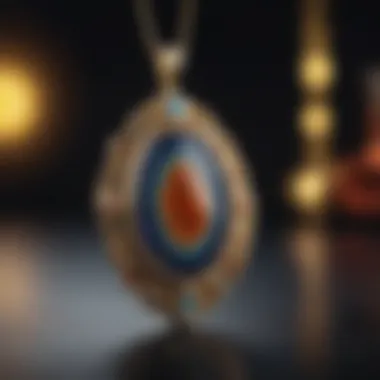
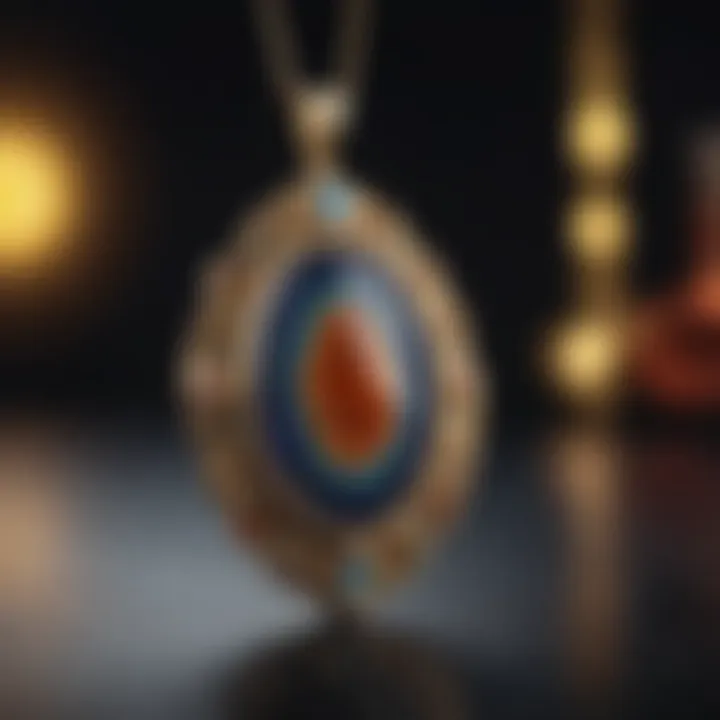
When working with drusy, it is advisable to cleanse the stones regularly. This practice ensures that the energy is not stagnant and remains conducive for supportive healing work.
In summary, the metaphysical attributes of drusy contribute to its growing popularity. Those interested in holistic healing often find drusy appealing for its purported emotional and spiritual benefits. As with any crystal, individual experiences may vary, but the collective voice endorses its virtues consistently.
This knowledge can enrich the appreciation and understanding of drusy stones, enabling gemstone enthusiasts to explore its depths in both physical and metaphysical domains.
Cultural Significance of Drusy
The cultural significance of drusy stones extends well beyond their aesthetic appeal. Drusy serves both as an object of beauty and a symbol within various cultural contexts. Historically, gemstones like drusy have played a crucial role in rituals, traditions, and as sources of inspiration for numerous artisans and collectors around the world.
Historical Perspectives
In ancient cultures, drusy stones were often associated with mystical properties and were used in different ceremonies or as talismans. For instance, in Native American traditions, certain gemstones, including drusy, were believed to hold the power of protection and were used as amulets. The intricate crystalline formations seen in drusy have been interpreted as nature's artistry, which inspired early craftsmen to create meaningful jewelry.
Archaeological findings suggest that drusy stones were valued in ancient Egypt, where they were sometimes interred with mummies to accompany them in the afterlife. This illustrates how these gems were seen as not only ornaments but as objects with spiritual significance. In ancient Greece, stones like agate drusy were often engraved and set in jewelry, showcasing their dual role as functional art and markers of status.
Modern Interpretations
Today, drusy stones continue to be celebrated, but their significance has evolved. In contemporary jewelry, drusy is a favorite among designers looking for unique surfaces that reflect light in captivating ways. The rise of handmade and artisanal jewelry trends has pushed various jewelers to incorporate drusy into their pieces, thus merging tradition with modern aesthetics.
Furthermore, the metaphysical community recognizes the unique qualities of drusy. Many believe these stones enhance the energies of other crystals, promoting inner peace and tranquility. This belief system has contributed to a renewed interest in drusy among collectors and enthusiasts seeking not only beauty but also a connection to the larger universe.
"Drusy stones are a testament to the unending journey of human creativity. From ancient rituals to modern adornments, they illustrate our continual search for meaning and beauty in the world around us."
In summary, the cultural significance of drusy is a multifaceted topic reflecting both historical traditions and modern interpretations. Its role in society has shifted, but it remains an important aspect of the gemstone narrative, linking us to our past while inspiring contemporary expressions of creativity.
Ethical Sourcing of Drusy
Ethical sourcing of drusy is critical in the gemstone industry. It emphasizes the need to obtain these valuable stones through practices that are socially and environmentally responsible. This section discusses the various facets of ethical sourcing, which ensures not only the integrity of the gemstones but also the well-being of communities involved in their extraction.
Importance of Responsible Practices
Responsible practices in sourcing drusy stones are paramount for several reasons. Firstly, they ensure that mining operations do not exploit workers. Many regions where drusy is mined may have limited regulations, leading to unsafe working conditions and unfair wages. By prioritizing ethical sourcing, buyers can support fair labor practices and advocate for the rights of miners.
Secondly, the environmental impact of mining cannot be overlooked. Traditional mining methods can result in significant ecological damage, including deforestation, soil erosion, and water pollution. Adopting responsible mining practices helps mitigate these effects. This includes choosing suppliers who use sustainable methods and are committed to minimizing their environmental footprints.
Moreover, ethical sourcing enhances the reputation of the gemstone industry as a whole. Consumers are becoming more informed and concerned about the origins of the products they purchase. By sourcing drusy ethically, jewelers and collectors can appeal to this conscientious market. Building a brand based on transparency and ethics can foster trust and loyalty among customers.
"The gold standard of ethics in sourcing gemstones does not merely lie in the product quality but in the principles that guide the extraction process."
Finally, ethical sourcing contributes to the preservation of local cultures. In many areas, gemstone mining is a significant part of local heritage. It's essential to engage with and support local communities to ensure they benefit from the mining activities. This could include funding for education, healthcare, or infrastructure projects, thus creating a positive impact in their lives.
In summary, the importance of responsible practices in ethical sourcing extends beyond mere compliance. It encompasses a holistic approach that benefits workers, the environment, the industry, and local cultures. By aligning the sourcing strategies with ethical standards, we can enjoy the beauty of drusy while supporting a sustainable future.
Care and Maintenance of Drusy Stones
Maintaining the beauty and integrity of drusy stones is essential for any gemstone enthusiast or collector. These unique formations, with their sparkling crystalline surfaces, require particular care to preserve their luster and prevent damage. Understanding how to clean and store drusy stones is key for keeping them in pristine condition.
Cleaning Techniques
Cleaning drusy stones should be done with caution to avoid scratching or dulling their surface. Here are common techniques:
- Gentle Rinse: Use lukewarm water to rinse the stone gently. Avoid hot water as it may affect the stone's quality.
- Mild Soap Solution: Mix a few drops of mild dish soap with water. Soak a soft cloth in this solution and use it to wipe the surface of the drusy. This method helps to remove oils and dust buildup.
- Soft Brush: For areas that require more attention, use a soft-bristled toothbrush to gently scrub. Ensure that the bristles are not too hard, as this may scratch the stone.
- Avoid Harsh Chemicals: It is important to steer clear of any abrasive cleaners or chemicals. They can damage the delicate crystalline structure of drusy gemstones.
Storage Recommendations
Proper storage of drusy stones can significantly prolong their lifespan and maintain their appearance. Consider these recommendations:
- Use Soft Cloth Bags: Store drusy stones in individual soft cloth bags to prevent scratches. Avoid using plastic bags as they may trap moisture.
- Keep in a Cool, Dry Place: Store the stones in a cool, dry environment away from direct sunlight. Excessive heat can alter the color and quality of the stone.
- Avoid Crowded Spaces: Keep the storage area organized and avoid placing too many items together. This reduces the risk of accidental chips or scratches.
- Regular Check-Ups: Periodically inspect your drusy stones for any signs of damage or deterioration. Addressing minor issues early can prevent bigger problems later.
Drusy in the World of Gemology
Drusy formations hold a significant place in the field of gemology. Understanding these unique structures is essential for gem enthusiasts and professionals alike. Drusy refers to a surface covered with tiny crystals, which can occur on a variety of minerals. This characteristic is not only visually striking but also adds to the diversity of gemstones available in the market. Such diversity is important for jewelers and collectors, as it opens the door to endless creative possibilities.
The classification of drusy is largely based on the mineral it covers and the size of the crystals. Classification helps in identifying the stone, which is a crucial aspect of gemology. Knowing how to identify drusy types can aid in valuing and appraising gemstones, making it a valuable skill for anyone in the industry.
Classification and Identification
Drusy can be classified according to several criteria. One of the main classifications is by the type of mineral that exhibits the drusy formation. Some gemstones, like quartz, show drusy characteristics more prominently.
When identifying drusy, consider these aspects:
- Mineral Composition: Understanding the base mineral is vital. For example, drusy quartz can have different properties compared to drusy calcite.
- Crystal Size: The size of the crystals can vary. Larger crystals might create a different esthetic than fine, tiny crystals.
- Color Variations: The color can also vary based on impurities and the parent mineral. This adds to the uniqueness of each piece.
Identification methods often include visual inspection and, infrequently, the use of tools like microscopes. Gemologists might also use tests to determine hardness and specific gravity, which help in confirming the identity of drusy samples.
Important Note: Proper classification and identification are crucial. Misidentifying a stone can lead to undervaluation or overpricing, impacting both buyers and sellers.
In summary, drusy holds a prominent position in gemology. Its classification and identification are key components that enhance the knowledge of gem enthusiasts and professionals. Through understanding these elements, it becomes easier to appreciate the intricate beauty and significance of drusy in the larger context of gemstones.
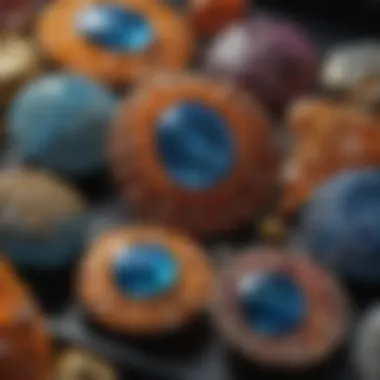
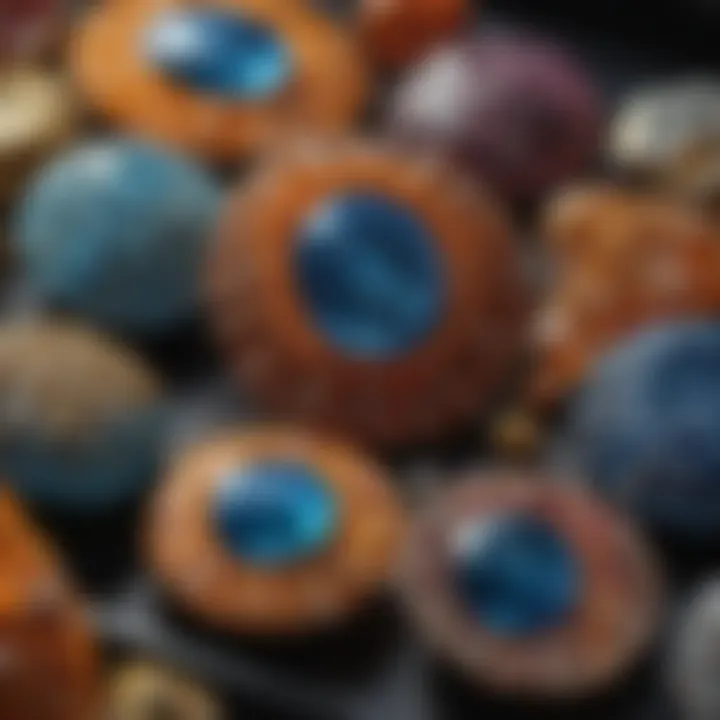
Comparative Analysis: Drusy vs Other Gemstone Forms
Drusy, with its captivating crystalline surfaces, offers intriguing features that set it apart from other types of gemstones. Understanding these differences is crucial for enthusiasts and collectors alike. By examining the comparison between drusy and solid crystals, one can better appreciate the unique characteristics and potential applications of these stones. This section aims to delve into the specific elements that differentiate drusy from solid crystals, exploring aspects such as appearance, formation, and usability.
Drusy vs Solid Crystals
Drusy refers to a layer of tiny crystals that form on a surface, creating a glimmering appearance. In contrast, solid crystals are characterized by their uniform, complete crystal structure. The primary difference lies in their formation process and resulting visual attributes.
Key Differences:
- Crystal Structure: Drusy crystals are often formed as a coating on a host mineral, leading to a textured surface. Solid crystals have a full, three-dimensional shape and often display a more uniform appearance.
- Light Interaction: The myriad tiny facets on drusy stones result in a unique light-reflecting effect, which can create a shimmering visual. Solid crystals, with their broader surfaces, reflect light differently, producing a less dazzling effect compared to drusy.
- Usage in Jewelry: Drusy is frequently used as an accent stone due to its eye-catching sparkle, often set in various styles, such as pendants and earrings. Solid crystals, on the other hand, are often used for statement pieces due to their size and solidity.
Benefits of Understanding the Differences:
- Enhanced Appreciation: Knowing how drusy differs from solid crystals allows collectors to make more informed choices regarding their gemstone selections.
- Creative Applications: Jewelers can leverage these differences to create unique, attractive pieces that highlight the distinct qualities of each gemstone type.
- Informative Decisions: Understanding the maintenance needs and durability of drusy compared to solid crystals can guide buyers toward better ownership practices.
Drusy provides a fascinating alternative to traditional solid crystals, offering both aesthetic appeal and unique characteristics. Recognizing the differences deepens appreciation and enhances the experience of gemstone collecting and jewelry design.
"Understanding gemstone differences enhances not just appreciation but also the creative potential in jewelry design."
For further readings on the gem properties, see Wikipedia and Britannica.
Whether you are a seasoned collector or a newcomer to the world of gemstones, grasping the nuances between drusy and solid crystals will enrich your understanding and enjoyment of these natural treasures.
Societal Perception of Drusy
The societal perception of drusy holds significant weight in understanding how these gemstones are valued and utilized in modern culture. Drusy refers to a layer of tiny, sparkling crystals that form on the surface of a host stone. These formations contribute to the aesthetic allure of various gemstones. As consumers become more aware of their unique characteristics, the importance of drusy in jewelry design and various cultural contexts has evolved.
Trends in Popularity
Drusy has seen a noticeable rise in popularity within both the jewelry market and fashion circles in recent years. This trend is influenced by several factors:
- Aesthetic Appeal: The shimmering surface created by drusy crystals captivates many. The unique texture and rainbow of colors invite touch and provoke admiration.
- Versatility: Drusy can be found on different base minerals like quartz and agate, making it versatile. Designers can incorporate it into various jewelry styles, from bohemian to more elegant pieces.
- Social Media Influence: Platforms like Instagram and Pinterest have propelled the visibility of drusy jewelry. These visually-driven sites have enabled gemstone enthusiasts and collectors to showcase their pieces, further fueling interest among a broader audience.
- Metaphysical Trends: Many people who appreciate gemstones do so not only for their beauty but also for their believed healing properties. This connection has contributed to the growing fascination with drusy.
- Sustainability Concerns: Consumers are increasingly drawn to responsibly sourced materials. Drusy can often be associated with ethical mining practices, appealing to the socially-conscious buyer.
The blending of aesthetics with modern values creates an environment where drusy is increasingly celebrated, reflecting a shift in how society views gemstones. As cultural perceptions continue to evolve, drusy may very well secure its place in the narrative of valuable natural treasures.
Challenges in the Drusy Market
The market for drusy gemstones faces multiple challenges that impact its growth and sustainability. Understanding these challenges is crucial for gemstone enthusiasts, collectors, and jewelry designers. The complexities not only influence supply chains but also affect consumer perception and ethical practices within the industry.
One of the most pressing issues is the environmental impact of mining. Mining activities, particularly for drusy, can disturb ecosystems and contribute to landscape degradation. The extraction process often requires heavy machinery, leading to soil erosion and the disruption of local habitats.
Environmental Impact of Mining
Mining for drusy-rich minerals can have a severe effect on the environment. These impacts are multifaceted and can range from the local level to broader ecological implications.
- Habitat Destruction: As land is cleared for mining, wildlife faces loss of habitat, impacting biodiversity. This destruction can lead to the decline of various species and disrupt local food chains.
- Soil Erosion: Without vegetation, soils become susceptible to erosion which can lead to sedimentation in nearby streams and rivers. This sediment can suffocate aquatic life, further exacerbating ecological stress.
- Pollution: Mining operations often release pollutants into the surrounding environment. Chemicals used in extraction or processing can seep into water supplies, affecting both flora and fauna, as well as local communities.
- Resource Depletion: Intensive mining not only affects the immediate area but can also lead to the exhaustion of local resources. Communities that depend on these natural settings for their livelihood can find themselves economically challenged as these resources become depleted.
Promoting responsible mining practices is essential for the future of drusy and for ensuring that it can continue to hold cultural and economic value. Sustainable mining initiatives can mitigate these impacts by focusing on methods that balance extraction with environmental conservation. By addressing these critical challenges, stakeholders can secure a sustainable future for the drusy market.
Future of Drusy in Gemstone Industry
The gemstone industry is constantly evolving and adapting to new trends, technologies, and consumer preferences. Drusy, known for its captivating crystalline surface and unique formation, is gaining increased attention among gemstone enthusiasts, collectors, and jewelry designers. Understanding the future of drusy is essential as it highlights the potential for innovation, market growth, and sustainability in responsible sourcing.
The future of drusy gemstones will likely be shaped by several key factors. First, the demand for unique and distinctive gemstones is on the rise. Buyers are moving away from traditional choices, seeking stones that offer character and individuality. Drusy’s unique appearance can set it apart from more common stones, making it an appealing option for jewelry designers.
Moreover, technological advancements in mining and lapidary techniques improve the quality and availability of drusy specimens. New methods can enhance efficiency and reduce environmental impacts, which is a growing concern in gemstone mining. As sustainable practices become more important, the industry may focus on sourcing drusy in a way that respects environmental considerations.
Another important element is the educational aspect surrounding drusy stones. As understanding of their characteristics and applications deepens, more consumers will appreciate them. This could foster a greater appreciation for drusy in both casual buyers and serious collectors.
"The journey of drusy in the gemstone market reveals not only its aesthetic value but also potential for sustainable practices in sourcing and production."
Emerging Trends
Drusy is experiencing several emerging trends that will influence its future in the gemstone market:
- Customization in Jewelry Design: There’s a growing interest in personalized jewelry that showcases individual styles. Drusy’s versatility in terms of color and texture makes it an ideal choice for bespoke designs.
- Sustainability Initiatives: Many consumers are now prioritizing eco-friendly products. Ethical sourcing of drusy gemstones can cater to this trend, promoting practices that minimize harm to the environment.
- Artisanal Craftsmanship: There is an increasing demand for handmade jewelry. This trend aligns well with drusy, as artisans can highlight the distinct features of each stone, creating pieces that tell a story.
- Digital Platforms: With the rise of online marketplaces, vendors can showcase drusy stones to a wider audience. This exposure can facilitate increased sales and spark interest in drusy's cultural significance.
In summary, the future of drusy in the gemstone industry appears promising. As awareness and appreciation for these unique stones continue to grow, opportunities for innovation, ethical sourcing, and customization are likely to expand. This evolution will not only benefit consumers but also contribute to a more sustainable gemstone industry.
Epilogue
The conclusion serves as a critical element in any exploration of drusy. It synthesizes the myriad aspects discussed throughout the article, tying together the diverse characteristics, types, cultural significance, and market challenges related to this unique gemstone formation.
Understanding drusy is essential for gemstone enthusiasts, collectors, and jewelry designers who seek to deepen their appreciation of these stunning formations. This knowledge fosters an awareness of the distinct visual traits, such as the crystalline surfaces that differentiate drusy from other gemstone types.
Moreover, the conclusion emphasizes several key considerations:
- Cultural Importance: Recognizing drusy's historical and modern significance in various cultures allows for a richer appreciation of the gemstone.
- Market Trends: Awareness of trends can inform collectors and designers about the evolving nature of drusy in the gemstone industry.
- Responsible Sourcing: Ethical considerations around sourcing are crucial for the sustainability of the gem market and for the integrity of the stone itself.
In essence, the conclusion reinforces the relevance of drusy and provides a comprehensive overview that can enhance the reader's understanding and appreciation of this exquisite gemstone formation.
Key Takeaways
- Drusy exhibits unique crystalline surfaces that distinguish it from other gemstones.
- Various types of drusy stones exist, each with distinct characteristics.
- Understanding the cultural significance of drusy enriches one's appreciation of its beauty.
- Ethical sourcing practices are vital for sustainable gemstone ownership.
- Awareness of market trends aids collectors and designers in making informed choices.



